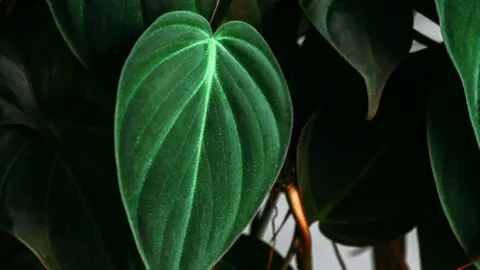In this article, I am talking about Philodendron micans care. The Micans is a trailing or climbing plant almost identical to a juvenile Philodendron melanochrysum. The P. micans is much easier to grow and much more affordable.
Philodendron micans Care
To care for Philodendron micans use a well-draining potting soil using peat moss, perlite, vermiculite, and potting soil in a ratio of 3:2:1:1. Water once the top 1” of soil dries out. The temperature should be between 65-75°F (18-24°C). A humidity of >50% and monthly balanced fertilizer during the growing season work best.

What is a Philodendron Micans?
Philodendron micans is a trailing plant that can climb a pole or hang down.
Occasionally, you will see the Philodendron micans with other names, such as Velvet Leaf Philodendron.
The botanical name for the plant is Philodendron hederaceum var. hederaceum.
The micans is easily confused with a juvenile Ph, melaonchrysum.

Philodendron micans leaves grow into many colors depending on how much natural light they get. They can be deep green, to chartreuse in color.
Native to the Caribbean and Mexico, these plants have velvety, heart-shaped leaves and a dark copper color on the underside of the leaf blade, according to Vermont University.
I don’t mind that it gets scraggly, and I let one of mine overgrow its shelf.g
Philodendron micans
| Species | Philodendron micans |
| Synonyms | Philodendron scandens 'Micans', Philodendron cordatum |
| Family | Araceae |
| Genus | Philodendron |
| Growth | Trailing, Climbing |
| Height | 3 feet |
| Width | 3 feet |
| Soil | Requires well-draining soil that is rich in organic matter. |
| Watering | Every 7-14 days |
| Light | Bright Indirect |
| Temperature | 60-80 °F (16-27 °C) |
| Humidity | 50-80% |
| Fertilizer | Fertilize monthly in spring and summer |
| Propagation | Stem cuttings or division of mature plants |
| Toxicity | Toxic to cats and dogs as well as animals. Causes irritation and rashes. |
Table of Contents
Philodendron Micans Soil – This Recipe Just works!
Philodendron micans grow well in any high-quality, fast-draining potting mix using peat moss, perlite, vermiculite, and potting soil in a ratio 3:2:1:1.
I typically mix my potting soil using peat moss and perlite with vermiculite and potting soil. One of my plants is growing completely soilless on a plant wall using felt.
Common misconception: Plants need soil. This is incorrect. Plants only need nutrients, water and a substrate to hold on to. This is why semihydro or hydroponics works.
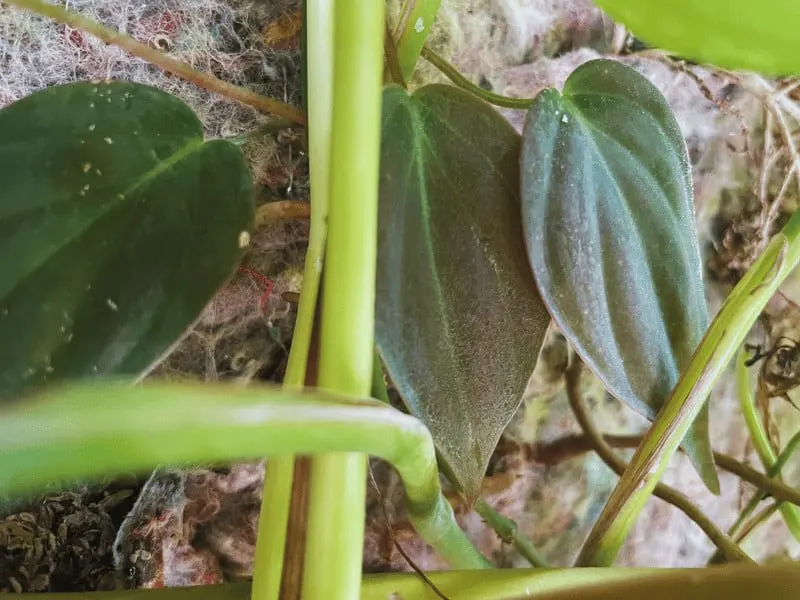
Light
Philodendron micans prefer bright indirect light.
Direct sunlight is not ok for Philodendron micans as it can burn the leaves.
If your window has direct sunlight, place the plant a bit further away from the window so that its light source is bright but indirect.
Philodendrons will tolerate lower levels of light, but they will not thrive.
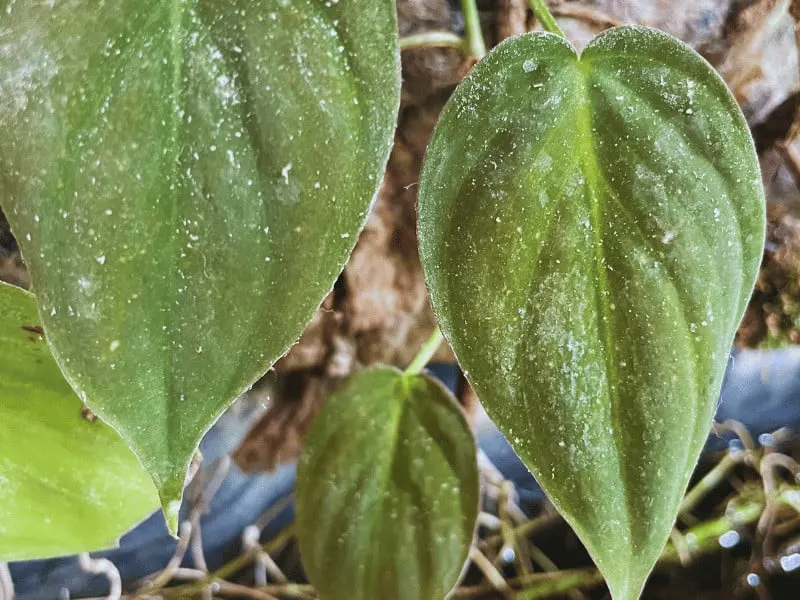
Philodendron Micans Watering – How often you have to Water Depends on the Circumstances
Allow the top inch of soil to dry out between watering (2.5 cm). I water about once a week as a general rule of thumb.
I check this by inserting my finger in the soil, and if it is dry to my first knuckle, then it is time to water.
Pour water from the top until it runs out of the drainage holes in the bottom of the pot.
If the leaves get droopy, the plant has been overwatered. This will correct itself once the watering schedule is fixed.
I water more in the hot months, and in the winter months, I let the soil get dryer in between watering. They are a forgiving plant if the schedule gets thrown off.
But how often to water is totally dependant on the circumstances your plant is in. The Velvet Philodendron on my plant wall gets waterd 4-times a day. Can you believe that? This is no issue becasue it is in felt and not in potting soil that can get soggy.
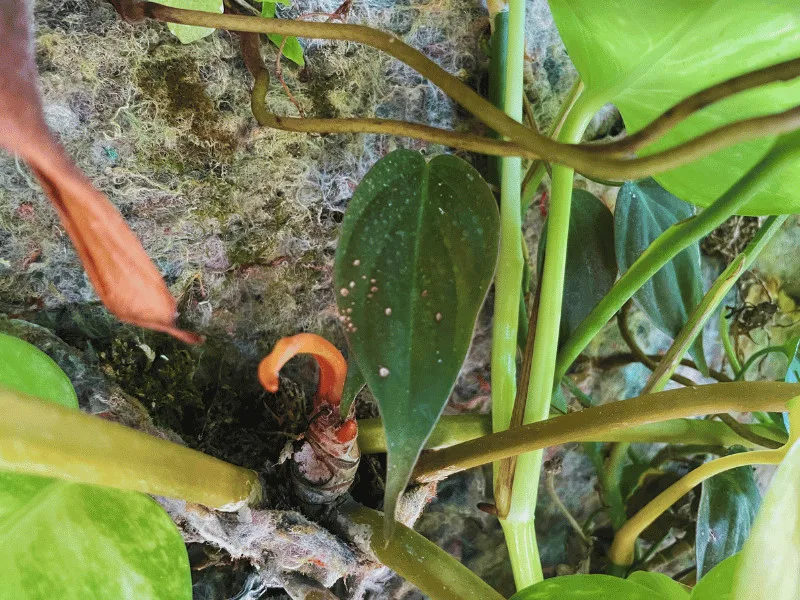
Philondendron micans Temperature – What works?
Philodendron micans do best in temperatures between 65-75 Fahrenheit during the day and around 60 Fahrenheit at night (16 degrees Celsius).
Avoid temperatures below 59 degrees Fahrenheit (15 degrees Celsius) as the growth of Philodendron micans will slow down considerably.
When the temperature is too low, the leaves change color and turn light brown to red. I have a problem with my grow tent this winter. The temperatures got below 50 degrees Fahrenheit for weeks (10 degrees Celsius). This resulted in most of my Micans cuttings dying in the grow tent. I was only able to save a few.
Philodendron micans Humidity – This can speed up growth!
Since Philodendron micans are from the Caribbean and Mexico, they thrive in humid conditions of >50%.
You can mist their leaves during the dry months in spring and summer. But I mostly do not do it as you risk fungal infections on the leaves. Great air circulation is key so the leaves dry quickly.
January is the most humid month, and March is the least humid in the Caribbean, so that tends to be their growth schedule.
For example, annually, the average humidity for the Dominican Republic is 82%, and although it doesn’t need to be that humid for your plant, the higher the humidity, the better for Philodendron Micans.
Fertilizer
Use a balanced fertilizer for Philodendron micans once a month during the growing season Philodendron Micans.
Philodendron micans are fast-growing and must be fertilized monthly in the spring and summer months and every other month in the fall and winter.
They can be fed with a balanced houseplant feeder. The fertilizer you choose should contain macro-ingredients.
If you notice that your Philodendron micans have small leaves or are growing slowly, it can indicate that it requires more fertilizer.
I find that sometimes my Philodendron micans get pale leaves, and this is due to a lack of magnesium and calcium, two ingredients in a well-balanced fertilizer.
Philondendron Micans Propagation
The easiest way to propagate Philodendron micans is to use stem cutting.
I find that the best time to do it is in the summer or even the early spring.
Choose a healthy branch with one or two nodes and cut it off with sharp scissors or a razor blade.
I sometimes have to remove some lower leaves to expose a few nodes.
Put the cutting in a glass of water or a glass with some very moist soil in it.
The roots will grow quite easily, and the cutting can be planted in a pot.
Growth
The Philo Micans grows to an average size of 8 to 12 inches tall (20-30 cm) and 24 inches (61 cm) wide at its mature stage. They are a fast-growing plant. The leaves never grow more than three inches wide (7.5 cm)
Potting and repotting
Repot Philodendron micans once it gets pot or root-bound and use a pot 2-3” (5-17.5cm) larger than the old one.
I always give my Philodendron Micas a fast-draining and good-quality pot. I like a ceramic pot or a hanging basket.
If the roots get wrapped in a compact ball, give your Philodendron micans care and repot it.
Choosing a pot that is only a bit larger than the root ball is best.
I use one 2-3 inches bigger (5.0-7.5 cm) than the root ball, and I always do it in the winter before the fresh leaves grow.
That seems to yield the best results for me.
Common Pests
With the proper Philodendron micans care, pests will be easier to manage and eliminate.
The most common are aphids, mealybugs, spider mites, and scale.
To have a healthy plant, I find it important to keep it pest-free as naturally as possible.
I use neem oil or horticultural oil.
I have also sprayed the plant with an insecticidal soap and water mix, and it keeps the pests away.
Mealybugs can be wiped off with a cotton ball and rubbing alcohol.
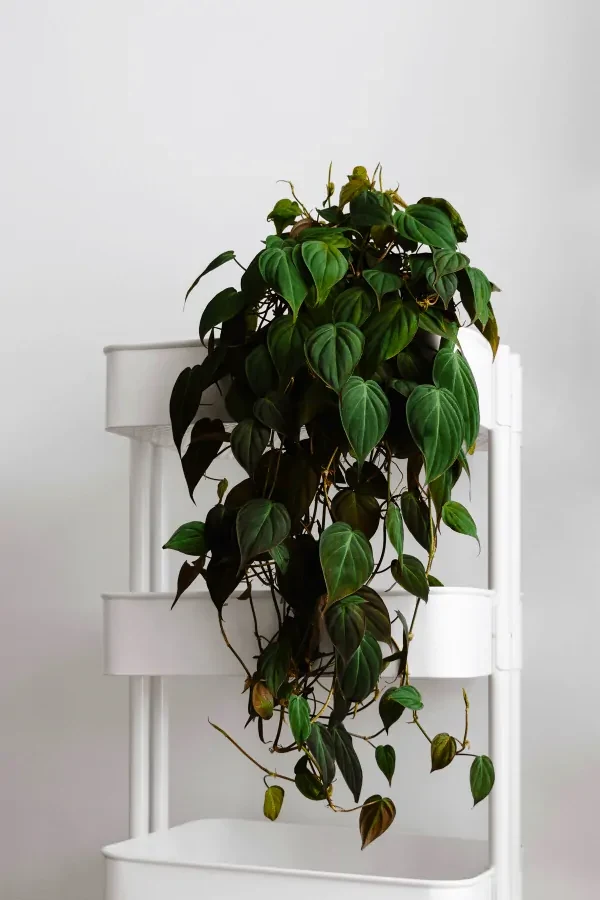
Philodendron micans Propagation
Philodendron micans can be propagated using stem cuttings.
Wait until the growing (spring or summer) season to propagate.
Inspect your plant.
A good time to propagate your plant is when you are pruning it back anyway.
To cut a stem for propagation, you can either do one leaf to one node or two leaves to two nodes.
Make clean cuts on the stems you plan to use for propagation with sharp scissors.
You can do a 1:1 or 2:2 leaf-to-node ratio.
They need the leaf to do photosynthesis, and the stem is just a way of transporting nutrients to the plant, so a shorter stem (approximately 2 inches) is best.
The node is where the leaf or aerial root grows out of the stem. Ensure your cuttings have a stem and leaves are healthy and vibrant.
Place the cut ends in a small jar of water or a watery soil and water mix. Another option is to propagate with wet moss.
Soak the moss and put some in the jar, creating a wet moss mix. Gently place the cuttings in the moss, being careful not to damage them as you do.
Once the cuttings have strong roots, transplant them into small pots with soil. Two months after I place the cuttings in water is usually a good time.
Is the Philodendron micans toxic?
The Philodendron micans contain insoluble calcium oxalate chrystals and are toxic to cats, dogs, and humans.
The Pet Poison Hotline generally ranks Philodendrons as toxic.
Is the Philodendron micans rare?
The Philodendron micans is not a rare plant. This doesn’t mean that it is easy to find. Very few stores seem to stock this stunning climber.
There is variegated Philodendron micans called Philodendron micans ‘Aurea’ that costs at least 10-times as much and is quite rare. It sports yellow variegated leaves.
You can buy a variegated Phildeondron micans at Zeroplants.
There is also a Micans halo. That plant has white variegated stripes at the edges of the foliage.
FAQ
Where can I buy a Philodendron micans plant?
You don’t have to make any special trips for a Velvet Philodendron. They are available regularly at garden centers and home gardening stores. You can also buy it on Amazon.
Does my Philodendron micans care need to include regular pruning?
Removing unhealthy leaves from any plant is a good idea. The vines can get long and scraggly. I find that when I prune them back, the plant gets fuller and bushier, which for me, works better in my small space. It makes the plant less leggy and lusher and fuller. When you are pruning, always use clean, sterilized scissors and make a clean cut below the node.
Do I need a humidifier for my Philodendron micans care?
You shouldn’t need one if you live in a naturally moist or humid environment. If you live in a dryer climate, a humidifier benefits the overall health and growth of Philodendron micans.
The last Words
Philodendron micans care is easy, and the plant is highly affordable.

Daniel has been a plant enthusiast for over 20 years. He owns hundreds of houseplants and prepares for the chili growing seasons yearly with great anticipation. His favorite plants are plant species in the Araceae family, such as Monstera, Philodendron, and Anthurium. He also loves gardening and is growing hot peppers, tomatoes, and many more vegetables.

